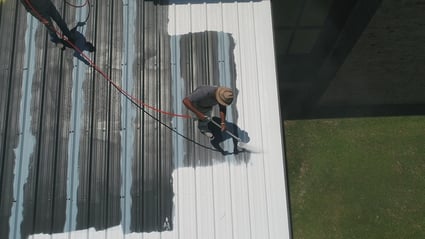There are several different types of commercial roof coatings used today, including silicone, acrylic, aluminum, and polyurethane. They are sometimes referred to as restoration membranes because roof coatings are often applied over existing rooftop membranes, as opposed to being part of a new roof construction detail. They can also be used in partial applications to coat and re-coat parapet walls or portions of a roof.
aluminum, and polyurethane. They are sometimes referred to as restoration membranes because roof coatings are often applied over existing rooftop membranes, as opposed to being part of a new roof construction detail. They can also be used in partial applications to coat and re-coat parapet walls or portions of a roof.
At this time, the major competitors in the commercial roof coatings industry are really only one of two types: silicone and acrylic. Let’s consider some of the key aspects of these coatings such as longevity, application, cost effectiveness, climate appropriateness, sustainability, and maintenance.
Because reflective roofs can moderate energy use over the course of a new or even an existing building’s lifetime and because energy savings mean cost savings, certain coatings can be a sustainable choice in most climates. Also, because roof coatings can prevent a full-blown roof replacement, let’s also understand that commercial roof coatings just make good sense to any business trying to save some money over the long term.
Types of Roof Coatings
Silicone coatings are solvent-based and last longer than other coatings because of durability. Though they are often installed with a fabric reinforcement to prevent tearing. Whereas some coatings can become brittle over time, they win the longevity contest which is the primary reason why they are one of the two most commonly selected roof coatings. At the end of 10 to 15 years, you simply recoat the surface. Silicone is suitable for any roof slope and has ultra-low VOCs. One of their disadvantages however is that they tend to lose reflectivity because of their tendency to hold surface dirt which makes them difficult to keep their surface clean and reflective. They tend to be more expensive than acrylic coatings.
Acrylic coatings are water-based materials and therefore they tend to be a cost-effective solution for a variety of roofs. They work in almost all climates and generally provide a good balance of cost and performance. Acrylic coatings are quite reflective, UV resistant, and easy to maintain. The disadvantage of acrylic is that it is a less durable material than some of the other coatings, is easily eroded by water over time and unfortunately does not respond well to roof ponding.
Aluminum roof coatings generate over 50% surface reflectivity, are suitable for most climates, for low and steep slope roofs, and are relatively durable. The downside to aluminum roof coatings are they are not inherently good for waterproofing like silicone and acrylic, and because they cannot adhere to water-based roof coating systems like acrylic they really are not a sustainable choice.
Polyurethane is perhaps the most impact resistant of all the coatings. Two types of polyurethane coatings, aromatic and aliphatic, provide quite different characteristics. The aromatic coatings are cheaper but are not UV stable. For this reason, they are often used solely as a base coating. Aliphatic coatings are more expensive but do happen to be UV stable, hold their color, and repel dirt more effectively than the other types of coatings. This means that though more expensive than the acrylic coating, for example, a hybrid aliphatic and aromatic system is durable and will function well as a cool roof when a light color is selected. In addition to often higher cost, a major disadvantage of polyurethanes is they give off harmful VOCs during application.
No matter which roof coating you select, commercial roof coatings are cost sensitive ways to prolong the life of your roof while also promoting energy efficiency and ease of maintenance. Like proper roof supports, they are part of an overall smart strategy to maximize the life of your roof through a common-sense approach to basic maintenance.



